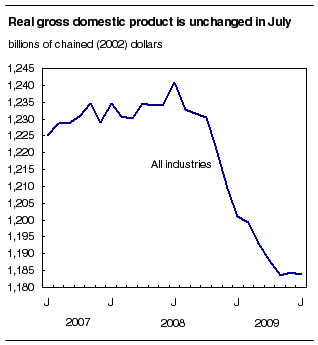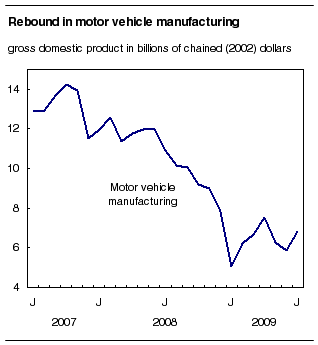Common menu bar links
Gross domestic product by industry
Archived Content
Information identified as archived is provided for reference, research or recordkeeping purposes. It is not subject to the Government of Canada Web Standards and has not been altered or updated since it was archived. Please "contact us" to request a format other than those available.
Real gross domestic product was unchanged in July, following a 0.1% increase in June. The strength of the manufacturing and wholesale trade sectors was attributable to a rebound in motor vehicle and parts production. There was also an increase in the accommodation and food service sector.

These gains were offset by declines in the mining sector, which were due in part to temporary closures, and in utilities. Construction, retail trade and municipal public administration were also down.
Growth in manufacturing
The manufacturing sector advanced 0.8% in July, after nine consecutive monthly declines. Durable goods manufacturing was up 2.4%. Output of motor vehicles and parts increased 17%, as activities partially resumed on some assembly lines following temporary closures over the last few months. This production increase bolstered the output of other manufacturing industries.
Non-ferrous metal production and processing manufacturers (+22%) also resumed part of their activities in July. However, those results were weighed down by declines in fabricated metal product manufacturing and non-durable manufacturing (-1.0%).
Note to readers
The monthly gross domestic product (GDP) by industry data at basic prices are chained volume estimates with 2002 as their reference year. This means that the data for each industry and aggregate are obtained from a chained volume index multiplied by the industry's value added in 2002. For the 1997 to 2006 period, the monthly data are benchmarked to annually chained Fisher volume indexes of GDP obtained from the constant-price input-output tables.
For the period starting with January 2007, the data are derived by chaining a fixed-weight Laspeyres volume index to the prior period. The fixed weights are the industry output and input prices of 2006. This makes the monthly GDP by industry data more comparable with the expenditure-based GDP data, chained quarterly.
Revisions
With this release of monthly GDP by industry, the data incorporates the revised 2005 and the new 2006 input-output annual benchmarks, revised source data and improved methodologies. As a result, the monthly series have been revised back to January 2004.
For more information about monthly GDP by industry, see the National economic accounts module on our website (www.statcan.gc.ca/nea-cen/index-eng.htm).

Increase in wholesale trade
Value added in wholesale trade rose 1.6% in July. The volume of activity was up for most wholesalers. The gains were particularly strong in automotive products and building materials.
Mining sector declines
The output of the mining, and oil and gas extraction sector fell 1.5% in July, the ninth consecutive monthly decrease. Output of mining, excluding oil and gas extraction, was down across the sector (-4.2%), except for the coal industry. Iron mines as well as non-metallic minerals mines (which include diamonds) continued to feel the effects of reduced world demand, leading to some temporary shutdowns during the month.
Oil and gas extraction declined 0.4% in July. Support activities for mining, oil and gas extraction continued their downward trend of the last nine months, decreasing 11% in July.
Both electric power generation (-2.6%) and natural gas distribution (-2.7%) decreased because of weaker demand attributable to unseasonably low temperatures, particularly in Central Canada.
Decrease in construction
Activity in the construction sector declined 0.2% in July. Residential and non-residential building construction both decreased, while engineering and repair work increased. After several months of strong gains, the activity of real estate agents and brokers decreased 0.4% in July.
Retail trade down slightly
Value added in retail trade edged down 0.1% in July. The volume of activity was lower in food and beverage stores, and in electronics stores. The volume of activity in pharmacies, general merchandise stores (which include department stores) as well as clothing stores increased.
The finance and insurance sector remains unchanged
The finance and insurance sector remained unchanged in July. The increase in financial intermediation (loans and banking activity) was offset by the decrease in trading volumes on the stock markets and a drop in insurance services.
Other industries
The accommodation and food service sector posted a 0.6% gain in July, paralleling a sharp increase in the number of visitors from other countries. Activity in municipal public administration fell 1.6%, largely as a result of a strike by municipal employees in Toronto.
Available on CANSIM: table 379-0027.
Definitions, data sources and methods: survey number 1301.
The July 2009 issue of Gross Domestic Product by Industry, Vol. 23, no. 7 (15-001-X, free), is now available from the Publications module of our website.
Data on gross domestic product by industry for August will be released on October 30.
For general information, or to order data, contact the dissemination agent (613-951-4623; toll-free 1-800-887-4623; iad-info-dci@statcan.gc.ca). To enquire about the concepts, methods or data quality of this release, contact Bernard Lefrançois (613-951-3622), Industry Accounts Division.
Table 1
| February 2009r | March 2009r | April 2009r | May 2009r | June 2009r | July 2009p | July 2009 | July 2008 to July 2009 | |
|---|---|---|---|---|---|---|---|---|
| Seasonally adjusted | ||||||||
| month-to-month % change | millions of dollars¹ | % change | ||||||
| All Industries | -0.2 | -0.5 | -0.4 | -0.4 | 0.1 | -0.0 | 1,183,919 | -4.6 |
| Goods-producing industries | -0.8 | -1.6 | -1.7 | -1.5 | -0.7 | -0.4 | 320,381 | -13.5 |
| Agriculture, forestry, fishing and hunting | -1.2 | -1.7 | -1.2 | -2.3 | -1.5 | -1.6 | 23,804 | -12.8 |
| Mining and oil and gas extraction | -0.8 | -3.2 | -2.7 | -1.7 | -0.9 | -1.5 | 49,055 | -15.2 |
| Utilities | -1.3 | 1.3 | -2.2 | -0.7 | -0.8 | -2.4 | 28,552 | -8.5 |
| Construction | -0.6 | -1.0 | -0.6 | -0.7 | -0.6 | -0.2 | 69,197 | -7.8 |
| Manufacturing | -0.7 | -1.4 | -1.5 | -1.8 | -0.5 | 0.8 | 146,849 | -16.4 |
| Services-producing industries | 0.1 | -0.0 | 0.1 | 0.1 | 0.4 | 0.1 | 868,186 | -0.5 |
| Wholesale trade | -0.4 | -1.3 | 0.6 | 0.6 | 1.0 | 1.6 | 66,527 | -7.6 |
| Retail trade | -0.0 | 0.5 | -0.6 | 0.5 | 0.5 | -0.1 | 73,909 | -1.9 |
| Transportation and warehousing | 0.1 | -0.6 | -0.7 | -0.6 | 1.0 | -0.0 | 55,562 | -5.9 |
| Information and cultural industries | -0.2 | -0.2 | -0.4 | -0.3 | -0.3 | -0.3 | 45,775 | -0.8 |
| Finance, insurance and real estate | 0.5 | 0.4 | 0.6 | 0.4 | 0.7 | 0.2 | 253,094 | 2.4 |
| Professional, scientific and technical services | -0.1 | -0.3 | 0.0 | -0.1 | -0.1 | 0.0 | 60,525 | -1.1 |
| Administrative and waste management services | -0.8 | -1.0 | -0.5 | -0.7 | -0.6 | -0.2 | 29,878 | -5.0 |
| Education services | 0.2 | -0.1 | -0.0 | -0.1 | 0.0 | -0.1 | 60,721 | 0.6 |
| Health care and social assistance | 0.3 | 0.2 | 0.0 | 0.3 | 0.2 | 0.0 | 80,945 | 2.4 |
| Arts, entertainment and recreation | 0.7 | -0.5 | 0.4 | -2.2 | 0.5 | -0.1 | 11,051 | -1.3 |
| Accommodation and food services | 0.3 | -0.1 | -0.1 | -1.2 | 0.0 | 0.6 | 26,887 | -0.9 |
| Other services (except public administration) | -0.1 | -0.1 | -0.1 | 0.1 | 0.0 | -0.1 | 32,279 | 0.2 |
| Public administration | -0.0 | 0.1 | 0.1 | 0.1 | 0.0 | -0.3 | 71,405 | 1.1 |
| Other aggregations | ||||||||
| Industrial production | -0.8 | -1.7 | -2.0 | -1.6 | -0.7 | -0.4 | 227,322 | -15.2 |
| Non-durable manufacturing industries | -0.9 | -0.5 | -2.7 | 0.5 | 0.3 | -1.0 | 61,894 | -10.1 |
| Durable manufacturing industries | -0.5 | -2.0 | -0.4 | -3.7 | -1.3 | 2.4 | 84,704 | -20.9 |
| Business sector industries | -0.2 | -0.6 | -0.5 | -0.5 | 0.1 | -0.0 | 981,465 | -5.7 |
| Non-business sector industries | 0.1 | 0.0 | 0.0 | 0.0 | 0.1 | -0.1 | 202,524 | 1.0 |
| Information and communication technologies industries | 0.1 | -0.6 | 0.1 | -0.5 | -0.0 | -0.1 | 58,447 | -2.2 |
| Energy sector | -0.2 | -2.3 | -3.2 | -1.2 | 1.2 | -1.2 | 77,150 | -10.2 |

